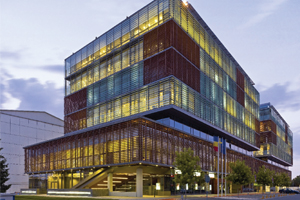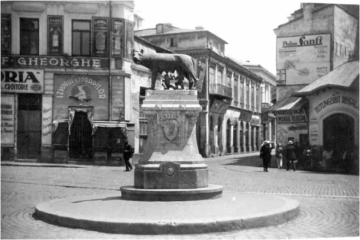
Timișoara’s new transhumance
The foreign investments boom brings in new commuters, but how can we transform it into a national development?
While the plane gets off the Otopeni runway, I’m counting the large amount of passengers going to Timișoara: they’re about 100. A third daily flight gets most businessmen and corporate white collars to Timișoara and only if there’s enough of them, Tarom, the Romanian air carrier, puts in place a larger Boeing 737, large enough to keep up with the traffic, a young recruiter explains.
There are only two to three daily flights from the Capital to Timișoara, and they’re usually done by smaller propeller-engine planes that shake like leafs to any turbulence. As travelling by train gets the 500 km to Timișoara covered in no less than nine hours for about 20-30 euro, anybody would gladly pay the 70 euro rate difference to get there by plane, in less than an hour. Unfortunately, not even some corporates organizations that I know of can afford to fly. But imagine the traffic if the yet prohibitive ticket fee of 100 euro per leg would get to fit the national middle class purchasing power!
Of course, lowering prices may be possible if there would be at least a jumbo jet each day in and out of Bucharest, Cluj and Timișoara, however, nobody cared about people’s and also foreign and local investor’s needs, from a ministry to a state-owned company managed by nepotism and lacking a development strategy coordinated with the economics of today.
As government officials still speak about finding a way to get through Carpathians faster, all of the other Central and Eastern European countries succeeded absorbing more than 95% of their EU funds and have their rapid rail and motorways.
The recent investments into western Romania determines Timișoara investors to seek for workforce abroad. Hungarian and Serbian workers as well as Romanians from as far as the Eastern city of Iași are summoned to cover the automotive and other investments explosion’s need for extra-workforce.
Flying over the Carpathians in a sunny day gives me the feeling of belonging. For many years, even before the communist regime collapse, I longed for ‘going west’. But the western mirage is happening right here and now, though slowly as a transhumant shepherd would. Until now, everything got delayed, postponed and underbudgeted.
As in 1989, everything seems to start in Timișoara, but the first major commuting trend towards the western Romania seems rather a long and tormenting transhumance.
For a Romanian, Iasi is further away from Timișoara than Munich or London. It takes actually at least 10 hours to get there on each affordable rail or road.
Transport minister promises we’ll get from Bucharest to western border point of Oravița, just south of Timișoara, in about 7-8 hours by rail… four years from now. But that’s too little, too late. While the Boeing 737 flies above some of the eight euroregions of Romania that are the poorest among the EU, crossing the Carpathians makes me think of the Swiss rail that drilled through the mountains centuries ago, or the Denmark-Swedish Oresund bridge boldly crossing the sea.
Yet, Romania benefits from EU funds worth 9.4 billion euro until 2020 for large infrastructure, says the EU funds minister. A national long-term infrastructure plan and a sovereign fund to accompany that may transform the country from the ground up in less than four years. Having at least some north-south and east-west highway network and city rings, not to mention rail refurbishment, may bring in such a tremendous amount of foreign investments that Romania has never seen.
Giving up on polluting coal industry and state-owned subsidized mammoths may reconvert the needed-workforce to build these new projects. And it will prove that dormant airports may become suddenly overcrowded, highways will get busy transporting more investments into the east and the transhumance started now towards Cluj and Timișoara becomes a real commuting phenomenon.
But for that to take place we need decision now. When communists (and now etatists) saw a problem they created a new committee, and this is exactly what we don’t need. Post-communist Romanian political leaders love to talk. Attending more than 100 debates a year, all I hear is “we need to…”. While we need foreign investments, and we must learn why
Timișoara has now an appetence of importing labor force from Hungary, Serbia and even farther to satisfy the demand. In Timișoara, the unemployment rate is practically null. Only who doesn’t want to work, does not have a job. Most automotive, industrial and outsourcing investors say they will double their production and personnel during the next three years.
Hiring from other countries and the farther Iasi brought in a new housing problem: Investors have had to host their 450-euro a month net wage workers into four and five star hotels, as Timișoara hosting amenities were temporarily overcrowded.
And complaining permanently that we’re not ready will not solve the problems. This year’s elections may see a new government, and lack of decision in assuming a long-term financing cycle and management and a long-term economic strategy to include a rapid recovery in infrastructure, energy, tourism and other fields will leave things unchanged, meaning that foreign investors will not pour in, they’ll just overcrowd the west, facing labor saturation.
While the Soviet Union norms issued in late 1940s forbade commuting, we see rather a sluggish transhumance towards the west even today. Old habits die hard, and the so-called Juncker instrument will not even allow us to move inside our own country efficiently, if we don’t decide to change all that now. And it is for this ‘Colectiv’ government to do some changes, now.









